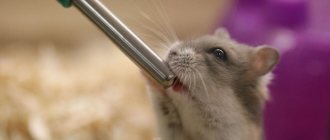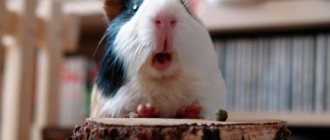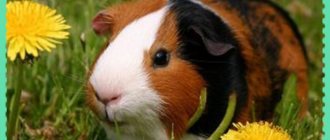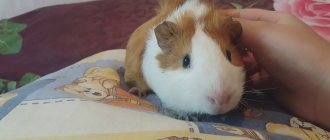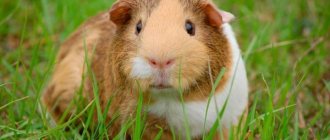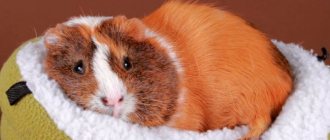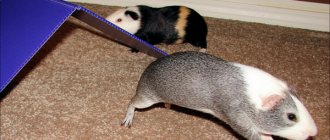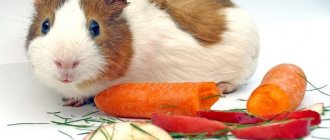The owner of a guinea pig needs to know how much water the pet usually drinks per day. After all, if the standard volume of fluid consumed changes significantly, the owner should notice this - this may indicate health problems.
Let's find out how much a guinea pig usually drinks, and also look at the reasons why it refuses water or, conversely, drinks too much.
Pregnancy
Each pig farmer determines when pigs will farrow at home:
- There are 4 days left until farrowing. Swelling of the vulva in a sow. The expectant mother should be placed in a farrowing pen or maternity cage so that in the future she cannot accidentally crush newborn piglets during feeding. White breeds of pigs are quite massive, so according to statistics, about 30% of babies die for this reason in the first days of life. Vietnamese breed pigs have less weight, but it is better to play it safe and provide a pen, or monitor the sow throughout the post-gestation period.
- Farrowing will occur in 2 days if you notice looseness in the udder, as this is a guaranteed sign of milky fluid production.
- There are only a day left until farrowing. An attentive farmer will note the increased restlessness of the sow, which will try to build a nest in the pigsty. Help her by providing enough quality straw, corn husks or sawdust to help her calm down. Check your gestation chart so you don't miss this period.
- Farrowing can begin after 6 hours. Proof: when you press on the nipples, colostrum begins to be released, and the genitals secrete mucus.
- Labor will begin soon, in about 30 minutes. This is easy to find out: the sow has calmed down, fallen on her side in a dark, secluded corner of the pigsty and is lying down. Fluid begins to be released from the birth canal, the first contractions appear, which means labor is coming soon.
- The beginning of labor. Increased contractions, tail wagging.
The signs of farrowing in a sow are the same for all breeds of pigs.
It's time to recover
After an attack of colitis, you should switch to raw fruits and vegetables gradually and carefully, starting with freshly squeezed juices. Under no circumstances eat vegetables whole, only finely chopped and little by little - 100-150 grams per day
You cannot make salads from several vegetables and fruits - introduce them into the menu one at a time, observing the reaction of the diseased intestines.
To restore impaired digestion, you will have to switch to a diet for a while: only porridge, and even those with water, and millet and pearl barley should be excluded. Soups should be cooked in low-fat broths. Grind boiled meat and fish, give up milk, replacing it with fermented milk products. Forget about fresh baked goods and brown bread. Replace white bread with crackers. It is harmful for chronic colitis to eat bread with bran and wholemeal flour. Boil eggs soft-boiled or make an omelet from them. Limit salt and sugar.
Article on the topic
Strength from the seed: grains strengthen the immune system and help maintain youth
Is it worth getting a guinea pig?
It all starts with a purchase, the acquisition of a future “member” of the family. Immediately decide the question of who will take care of the animal when the child’s interest in it “cools down.” Let him choose a new tenant for the house. Children tend to choose sad-touching, “unhappy” animals that are prone to various troubles with them.
The animal must be energetic, curious, enterprising and responsive to anyone addressed to it, it must have shiny, “cheerful” eyes and shiny fur. Lethargic, timid rodents huddled in a corner should not be taken into the house.
Don’t be scared by the animal’s “rapid” breathing; 100-150 respiratory movements per minute are the norm. But breathing should not be hoarse, hoarse and, under no circumstances, “coughing”.
A body temperature of 37 to 39 °C is not “fever”; for a rodent this is also normal, as is a pulse of 300 beats per minute. The body length is less than 20 cm, “failed” sides indicate poor health, it is better to refuse such an individual.
The purchased animal should not have lice, lice, purulent crusts from discharge from the ears, nose or eyes, or traces of diarrhea around the anus; At the same time, determine the gender of the “child”.
Main causes of death in pigs
All main causes of death are divided into two large groups. The first includes physiological or natural death from old age. The second group includes causes of unnatural death or pathological death. In turn, unnatural causes are divided into:
- Accidents, Diseases. Among accidents, the three most common causes of death are: Falling, Getting under the owner’s feet or getting stuck between walls and furniture, Blockage of the respiratory tract with food. Old age
Manifestations of old age in guinea pigs include decreased activity and appetite, weight loss and loss of interest in their relatives and owner. The animal tries to doze off more, spends time alone, looks disheveled and weak. Veterinarians claim that animals die not from old age itself, but from diseases that the weakened body cannot cope with.
Guinea pigs begin to age at nine to ten years of age, but how long the animal will live depends on the care and attentiveness of the breeder.
In old age, animals develop a variety of diseases and even a cold can cause serious complications, so it is recommended that older pigs be provided with more careful and attentive care, nutrition and exercise. Older animals may have problems with the kidneys and liver, heart function, and hormonal imbalances. If the disease is detected at an early stage, it is easy to treat, but an advanced disease will lead to the rapid death of the animal.
Prevention recommendations
For the well-being of your four-legged family member, it is important to notice any changes in his behavior and follow the following recommendations:
- Increase the number of preventive examinations after 7 years. Most diseases occur in older dogs with weak immune systems. Don't ignore walks and exercises to keep you fit. Stable exercise is the key to a healthy and strong body.
- Don't forget about communication. Be sure to make time for your four-legged friend even after hard work. If circumstances are against you, get several pets. Animals of the same breed, growing together from puppyhood, get along best.
- Make sure to maintain portion sizes when feeding. The standards are written directly on the packaging of dry food. The weight of a portion can be easily measured using a special cup from a veterinary clinic or pharmacy. A kitchen scale will also work. Remember that serving sizes depend on the age, size, gender and health of the animal.
- Follow the schedule of vaccinations and treatment against ticks and helminths. A vaccine is the most effective way to protect against most dangerous infections. Treat against worms every quarter, and against ticks during periods of their activity. When free-ranging in your own yard, do not forget to treat the area itself.
- Make sure you have a comfortable sleeping place. Make sure the bed or hutch is away from drafts and well heated.
- Don't skimp on feed and food. Poor nutrition impairs the functioning of the immune system and increases the likelihood of contracting infections. Before purchasing an animal, be sure to read the list of prohibited products. In addition to canned food, pickles and other obviously harmful foods, the consumption of raisins, grapes and avocados is prohibited.
- Make sure all household chemicals, construction chemicals and tablets are kept out of reach. Even short dachshunds are prone to jumping, so never leave medications on the bedside table or table.
- Regularly sanitize your sleeping area and dishes. Lack of hygiene attracts fleas and helminths, so don’t be lazy about disinfecting.
Follow basic care rules. Monitor the condition of your ears, eyes, mouth and skin. When processing, do not use cotton swabs or regular cotton wool. They can injure the eardrum or the mucous membrane of the eye. The safest tool is considered to be a cotton pad or a regular cloth soaked in water. When brushing your teeth, use a veterinary toothpaste designed specifically for animals. When examining the skin, do not forget to part the fur.
Often the problem of poor health associated with poisoning is explained by a lack of education. Every pet should know basic inhibition commands. If self-training has reached a dead end, sign up for UGS or OKD courses at the canine club. These courses are designed for four-legged pets living in the city.
Has your dog stopped eating and is lethargic? More than 20 reasons may be responsible for this. Animals, like children, cannot explain the cause of their illness, so responsibility for their health falls entirely on the owners. Time spent with your pet is an excellent opportunity to learn its habits and gain trust. A close connection between a person and a four-legged friend is the most reliable way to identify any abnormalities.
The article is for informational purposes only. Contact your veterinarian!
Major deadly diseases
Most diseases that lead to the death of an animal are caused by improper maintenance or feeding, as well as inattention to the animal. Some owners, when they detect alarming symptoms, turn to the Internet and forums, and go to the doctor too late.
Only in a veterinary clinic is it possible to make a correct diagnosis, and a veterinarian should prescribe treatment based on test results.
Some diseases occur very quickly and only a few days pass from the first symptoms to death. Therefore, it is necessary to know and understand the symptoms of dangerous diseases and be able to provide first aid.
Enteritis affects the digestive organs. Severe diarrhea is most often caused by a lack of hay or grass and a sudden change in the animal's diet. The most dangerous is the infectious form of the disease, which is caused by Escherichia coli. The bacterium changes the intestinal flora and multiplies quickly, leading to very sad consequences. The first symptoms of the disease:
- Convulsions, Bloody diarrhea, Paralysis of the legs, Wheezing, Refusal of food and water.
The infectious form of enteritis is practically incurable and death can occur in the first 12 hours after infection from exhaustion and dehydration.
Salmonellosis
Salmonellosis is caused by salmonella bacilli. The disease is one of the most serious and dangerous among infectious diseases, and some forms of the virus can be transmitted to humans. The animal dies from severe diarrhea and dehydration within the first 24 hours, but if you consult a doctor at a very early stage, there is a chance to save the animal. If the veterinarian has diagnosed salmonellosis, the owner must be tested for the presence of bacteria in the blood, disinfect the cage and room where the animal was kept, and carry out all treatment using disposable gloves.
The first symptoms of the disease:
- Severe diarrhea, refusal of water and food, difficulty breathing, salivation, high body temperature, tight tummy, and any palpation causes severe pain.
If, when contacting a veterinarian, the disease was already at a late stage, the doctor may suggest euthanizing the animal.
In this case, euthanasia is more humane and will allow the animal to avoid suffering and severe pain.
Pseudotuberculosis
Infection occurs through water and poor-quality food. The first symptoms of pseudotuberculosis in pigs:
- Loss of appetite, Apathy, Fever, Diarrhea, Convulsions, Paralysis.
The disease is infectious and can affect all animals in a very short time. If convulsions begin, the chance of saving the mumps is almost zero. After the death of the animals, the cage, as well as the feeders and drinking bowls, and the entire room around it should be disinfected - the body of the virus is very tenacious and can remain active for a long time.
Pneumonia is one of the most common causes of morbid death in guinea pigs. This is explained by the fact that it is not always possible to determine which virus caused the disease, and only after the death of the animal during an autopsy is it possible to detect the causative agent of the disease. Some forms of pneumonia are also dangerous for people. Treatment and consequences of the disease largely depend on the living conditions and quality of food of the pig, as well as on the timeliness of seeking medical attention. Weakened animals and animals suffering from vitamin deficiency are most often susceptible to the disease.
The disease manifests itself as follows:
- Decreased appetite, Lethargy, apathy, drowsiness, Increased thirst, Purulent discharge from the nose, Increased body temperature, Rapid and difficult breathing, Convulsions.
The very first symptoms are a runny nose and purulent discharge, and it is with these that you should immediately consult a doctor. A sick animal is isolated from all other animals, and all manipulations must be carried out using disposable medical gloves. Most often, treatment consists of a course of oxytetracycline or sulfonamide injections, as well as the addition of vitamin and mineral supplements. During the treatment period, an important role is played by the abundance of juicy and green food, sprouted grains of oats or wheat, and fruits in the animal’s diet.
If the visit to the veterinarian was timely, then the chances of recovery are quite high.
Features of water consumption by cats
All cats drink a little water. The reason is their origin. The homeland of cats is North Africa. Wild cats lived in arid areas with limited water. Like all savannah and desert animals, cats lack a sweating mechanism. In the absence of moisture in the cat's body, a process of reverse filtration from the bladder occurs. Lions can go without water for up to 5 days without harm to their body if there is no river or lake nearby.
shutterstock
Reasons why a cat drinks little water:
type of feed; character traits; health status.
The moisture content of food is an important consideration for a cat's water intake. Wet food and canned food reduce the cat's need for water. A diet based on dry food increases the need for water for their absorption several times. There is a water consumption ratio when feeding dry food: 1:2.5-3.
Otherwise, food that is not swollen properly will block the intestines, causing constipation and obstruction. Milk and broth are also liquids that are taken into account in the cat’s water consumption. If an animal loves milk and does not drink water at all, this means that it does without drinking water.
It is necessary to take into account the animal's habit. An adult cat switched to dry food will drink as much water as a kitten is used to drinking. Cats are very conservative in their habits and are difficult to retrain as they age.
The peculiarity of the animal’s character is also reflected in its attitude towards the container from which it drinks and the quality of the water. Clean cats that lick themselves from the tip of their ears to their tail are very likely to be very squeamish, and therefore demanding of the water bowl and water. They will prefer to drink from a tap or from a container with a large capacity or area.
shutterstock
Cats who have the patience to wash their front paw and half their face are likely to be more indifferent to the cleanliness of their dishes. This factor should not be taken into account if there is a cat living in the house that does not wash itself at all, according to the characteristics of its breed. But, in general, these animals will not drink stagnant water from a dirty bowl.
A painful condition may cause the cat to not drink water at all. The most dangerous thing is to infect an animal with rabies. Hydrophobia is one of the first symptoms of this disease. Knowing the signs of the disease, the cat owner must take the necessary measures in time to isolate the animal.
Fever caused by infection can also cause refusal of water. In this case, the cat does not drink because he does not have the strength to do so. Internal damage due to a bad landing, cat fights, dog teeth or human anger is the reason for the cat's powerlessness and reluctance to drink water.
Stress and lack of thirst
Refusal of water and weight loss are signs of stress experienced by the animal. Usually new pets are susceptible to it - everything around is unfamiliar and this makes the rodent feel uneasy. When the adaptation period passes, the animal will begin to consume water as usual.
In addition to moving to a new place, the main causes of stress are:
- death of a relative;
- noise and loud sounds;
- sharp, strong odors;
- bright light;
- changing your usual diet;
- sudden change in temperature, humidity, etc.
If the temperature?
Children often refuse water at high temperatures due to poor health. This is bad, parents need to use all known methods to avoid dehydration and cramps.
What do we have to do:
- humidify the air;
- lower the room temperature;
- ventilate the room;
- put the baby to the breast more often;
- persistently offer water day and night;
- feed according to appetite;
- don't wrap up;
- give your favorite drinks;
- persuade.
The higher the temperature and the younger the child, the more persistent parents should be. Sometimes calling an ambulance and hospitalization is the only correct course of action. In addition, you can try to inject water with a syringe according to the instructions given above.
Read about how and how much water a child should drink here, and about the proper use of water by a person - here.
All the most important and useful information about how to drink water for children is presented in this section.
What is water for?
A person can live without food for several weeks, but without water - only a few days. On average, we are 60% water. It is the basis of blood, digestive juices, urine and sweat. Water is found in large quantities in muscles, adipose tissue, and the brain. Even bones are almost a quarter made of water.
We cannot store water and are losing it daily. Thus, up to 200 grams of water leaves the body daily in stool, from 500 to 1500 g in urine, up to 500 ml through the skin, and up to 400 ml through breathing. Water loss and need for it are affected by nutrition, air humidity and temperature, respiratory rate, metabolic rate, and activity level.
Water does many important things in the body:
- transports hormones, nutrients, oxygen to cells;
- acts as a solvent, making substances digestible;
- removes waste metabolic products from cells and from the body;
- an important molecule in most chemical reactions in the body;
- protects joints by acting as a lubricant and protective cushion;
- regulates body temperature through sweating;
- regulates blood pressure;
- Serves as a shock absorber inside the eye and spinal cord.
If the body loses more water than it takes in, varying degrees of dehydration occur. Among the symptoms:
- extreme thirst
- dry skin and mucous membranes (mouth, nose, eyes)
- fatigue and weakness
- decreased concentration
- fast fatiguability
- increase in body temperature
- headache
Does a hamster need water?
Hamsters can only live without water for 2-3 days. It all depends on the species. If your pet goes without fluid for seven days, dehydration and various illnesses may occur. It’s better to play it safe and leave your pet as much water as possible. An additional drinking bowl is very inexpensive, and you can buy it at any pet store.
To understand exactly how long a rodent can live without water, you need to consider:
The hamster loves to drink clean water and may refuse it on the second or third day.
There is a special drinking bowl that is mounted on the wall. A thin tube is stretched out of it. When the rodent wants to drink, it is enough for him to lick his thin nose. Water will flow out of it. This way the liquid does not spill and retains its beneficial properties longer. Hamsters are very smart and always find water in the nipple drinker.
How long can a rodent live without water? From three to seven days. But it’s better not to check, but to take care of proper care for your beloved pet. Such experiments can negatively affect the health of the hamster.
The guinea pig has lost his appetite. What to do?
Contents hide
The guinea pig has lost his appetite. What to do?
We received an alarming letter from the owner of a guinea pig. His pet refuses to eat and has noticeably lost weight. The animal also drinks very little; there are practically no natural wastes. As the owner notes, even the eyes have become somewhat cloudy and sad; it is impossible to look without pain in the soul. The matter is complicated by the fact that our reader lives in a rural area and is quite far from a veterinary clinic. We ask a specialist for advice!
What the reader is absolutely right about is that he sounded the alarm absolutely justifiably. These symptoms indicate that not everything is all right with the guinea pig, and the intervention of a qualified specialist is really necessary.
If you notice a decrease in appetite in your pet, be alert immediately
Pay attention to how much fluid he consumes and whether he is constantly thirsty. If your guinea pig begins to drink noticeably more, the situation is serious.
Animals often suffer from diabetes, and extreme thirst is one of the main symptoms of the disease. Urinary tract diseases are also possible - in this case, the guinea pig also drinks a lot. Finally, it is not uncommon for these animals to have dental problems, which also cause an increased feeling of thirst. Please do not brush off dental problems: if a guinea pig cannot eat food properly and chew it, it will die very quickly.
These cute rodents are also characterized by the fact that all their ailments and diseases develop quite quickly, leaving very little time for making a correct diagnosis and prescribing treatment.
As the reader rightly noted, his pet, having barely begun to refuse food, sharply lost weight. This means that the animal’s body does not receive enough nutrients and vitamins from food that are so necessary to maintain health. The daily calorie intake is not maintained - this becomes critical for the very fragile organism of guinea pigs. Against the background of malnutrition, so-called hepatic lipidosis quickly develops. We may upset our correspondent, but if you are late to the veterinarian, the animal’s immediate death is almost inevitable. But turning to a specialist does not provide a 100% guarantee of recovery, although the likelihood of a successful outcome certainly increases. In any case, we treat hepatic lipidosis in a hospital setting.
What should you do before going to the vet? First, keep your guinea pig away from other pets if you have any. Secondly, make sure that the animal is in a quiet, safe and not too hot place. Monitor your fluid intake. Take all measures in your power to ensure that the animal takes food. Don't forget that guinea pigs need vitamin C (either in its pure form or in products containing it; you can add the vitamin directly to the water). Don’t be afraid, give your pet all his favorite treats - now the main thing is that his body somehow receives the much-needed calories. Try everything, go to any tricks. And, of course, do not hesitate to visit the veterinarian!
Diseases accompanied by lack of thirst
As you know, a pet refuses food and water when it is sick and feels unwell. If an animal ignores drinking, it means that its body contains excess fluid. This is directly related to swelling. Swelling is a characteristic symptom:
- Heart attack;
- urolithiasis;
- pneumonia;
- lesions of the pulmonary system;
- renal failure;
- problems with blood vessels;
- heart diseases.
With the listed diseases, a protective process is launched in the animal’s body. Excess fluid will leave the rodent's body faster if water stops entering the body. To speed up its healing, the animal refuses to drink.
If you suspect your animal has a disease, you should consult a veterinarian as soon as possible. He will examine the pet and make an accurate diagnosis. A veterinarian should prescribe therapy; independent treatment can only worsen the situation.
Why doesn't my hamster drink water?
Sometimes the owner of a rodent is concerned about the constant level of liquid in the drinking bowl. To prevent your pet from becoming dehydrated, you need to consider several reasons:
- The hamster is not used to using the drinking bowl. You need to bring the animal to the tip of the sippy cup and moisten its face with a drop of water.
- Abundance of succulent food.
It happens that the animal is capricious and does not use the drinking bowl. Abrupt refusal may mean:
- The hamster is not satisfied with the quality of the water.
- No access possible. Different drinker configuration or malfunction.
- Musty moisture. It is necessary to wash the tank and fill it with clean water.
Watch the video on how to teach a hamster to drink from a drinking bowl.
There is a lot of debate about whether hamsters need to drink. The rodent is able to balance the level of fluid in the body itself, but even with low consumption, the animal cannot be denied free access to water. With timely care and attention, a small pet can delight its owner for many years.
Water consumption changes throughout their lives
It's also worth noting that a guinea pig's water intake can change over the course of their life. As my boar guinea pig got older (and had a diet richer in the celery and cucumber mentioned above), he almost completely stopped drinking from his water bottle. And yet he remains happy, healthy and cheerful.
What to do if your guinea pig stops eating or drinking
Guinea pigs have a good appetite and excellent mood. A healthy animal is always chewing something, joyfully rushing towards the offered treat and the hands of its beloved owner. If a guinea pig does not eat or drink, becomes drowsy and lethargic, it means that the little pet is sick. During wakefulness, he does not move, refuses treats and fun games with humans. Lack of appetite and lethargy are symptoms of many infectious and non-infectious diseases of rodents. If your guinea pig does not eat, you need to contact a specialist as soon as possible who will diagnose and prescribe treatment.
The dangers of not eating
The guinea pig stopped eating. Refusal to eat can provoke:
- disruption of microflora and intestinal functioning;
- inflammation;
- severe diarrhea, which can lead to the death of the animal;
- intestinal arrest;
- bloating.
Important! If food does not enter the body for a long time, the nerve endings of the digestive organs die. This results in the stomach not receiving signals to contract, which means food cannot move around. The point of no return occurs after sixteen hours of fasting.
Green feed
So, this food must be consumed by your guinea pig. Her diet should be varied if possible. Therefore, you can give your guinea pig red clover, meadow grass, plantain, and yarrow.
Please note that greens must be chosen carefully, because some plants can be harmful to rodents
What does a guinea pig eat besides roughage and fresh greens? Of course, vegetables (parsley, broccoli, Chinese cabbage, etc.). Let's talk more about this topic. As we have already found out, guinea pigs eat lettuce, and all its varieties. This food must be fresh, as the leaves spoil in a matter of hours.
The guinea pig also enjoys eating parsley. It contains a lot of magnesium, potassium, phosphorus and vitamins. It is valued for its antiseptic properties. Offer your pet dill as well. It contains iron, potassium and carotene. Dill reduces the formation of gases in the intestines. True, this greenery should not be given in large quantities, as it contains a lot of essential oils.
Cucumbers are the guinea pig's favorite food. Cucumber juice has a weak anti-inflammatory effect. Another advantage of this vegetable is its low calorie content. It is useful to give it to those rodents who need to lose weight. But you should not feed your young guinea pig only cucumbers, even though they love them very much. After all, a growing body must receive adequate nutrition.
The record holder for ascorbic acid content is sweet pepper. In addition, it contains a large amount of carotene. You need to feed the pepper in slices, but, of course, without seeds.
Another useful food for guinea pigs is carrots. It contains many vitamins, carotene, glucose and microelements.
Tomatoes should also be included in the rodent menu. They contain carotene and vitamin C. You should give your pet only ripe fruits. Green tomatoes should not be offered to rodents, as they contain solanine (a toxic substance). When ripe it is destroyed.
Cabbage is a healthy vegetable, but should be given with caution. It contains a lot of sugar, protein and vitamins, as well as organic sulfur
True, cabbage can cause severe gas formation. The rodent should be given only the top leaves of cabbage (preferably white cabbage). Although if you are new to keeping such animals, then it is better not to pamper your pet with such a product at all. It's best to give him broccoli little by little, it's not that dangerous.
What does a guinea pig eat, besides all of the above? Melons (pumpkins, melons, watermelons, etc.), which contain many vitamins and carotene. They should be given to the rodent in slices with peel. Zucchini and pumpkin are especially useful for these animals. They serve as dietary food. Pumpkin seeds are a preventative against worms. In addition, they contain many vitamins and microelements. They are also an excellent source of zinc. This element is necessary for the prevention of skin diseases and maintaining the skin in good condition.
Rules for caring for a rodent
Any animal needs a mate, it won’t “last” long alone, but if you bought a male and a female, then don’t let it be a surprise for you that they will have offspring 60-70 days after the first “meeting”.
In the future, the female will go into heat again after 14-18 days. You should not be too lenient about frequent matings: the mother’s body wears out faster from frequent farrowing.
But demanding abstinence from a male is also not the best solution to limit childbearing. Guinea pigs, like rats and other rodents, are very fertile: if farrowing brings from 1 to 5 cubs, repeated every 2 months, it is easy to calculate the possible litter for the year.
Whether or not you should have more than one pair of pigs is up to you. Please note that newborn pigs themselves will be able to bear fruit and reproduce within 40 - 60 days (depending on gender).
Article on the topic: Is it possible to give guinea pigs white cabbage, cauliflower and Chinese cabbage?
Consider the question of where the newly born offspring will be placed and where the males will be placed so that overcrowding does not lead to a deterioration in the health of your pets.
When transporting home, try to do it quickly, but in such a way that the pig is as calm as possible: do not shake, do not turn over, do not sharply tilt the box and let there be hay inside if the journey is long.
If the pig does not eat for 2-3 days after transportation, this is stress, leave it alone. The following can be said about “living conditions”: the pen-cage must be clean, warm (but not hot), and so that the pig does not “share living space” with hamsters, rats and other living creatures.
If there is an angry dog or cat in the house, make sure they get along. If this does not happen, there is another reason to abandon the animal, because it will regularly get scared or get damaged, and its life will not be too long.
How long can a chinchilla live without water and food?
This is far from an idle question. It arises among owners when there is a need to leave the animal alone for a short time or take it with them when going on the road.
In their natural habitat (the desert highlands of the Andes), chinchillas are content with dew and moisture from their food. This adaptive reaction is due to the fact that in the mountains one cannot rely on scanty and infrequent precipitation as a constant source of water.
It is believed that a chinchilla can live without food for a week. If she has plenty of hay and water, then such a hunger strike will not harm her health. The animal can live without water for more than a day, provided that it receives plenty of succulent food.
The figures given are arbitrary; you can use them as a guide if necessary. But testing their correctness by experimenting with an animal is hardly humane. Don't deprive him of food and drink without good reason.
Almost the only reason for forced starvation of a pet is indigestion. In this case, it is recommended to feed hay without restrictions.
Even if the doctor has prescribed a complete hunger strike, there is no reason to deprive the animal of water. Water should be available around the clock, especially during illness or hot weather.
During transportation, when fluid intake has to be limited, you can give your pet a dried apple. The moisture contained in it will be enough for the animal to last for the duration of the trip. True, you shouldn’t get carried away with apples, remembering their laxative effect on the animal’s intestines.
How long can a hamster live without food and water?
The hamster is a favorite pet of many adults and children. A cute little bundle can bring a lot of happiness to your home. It does not require complex care and a lot of time.
There are situations in life when a family needs to leave home. For example, go on vacation to the seashore. It is not possible to take a small pet long distance. There are several questions that owners ask themselves. How long can a hamster live without food? How to prepare housing for departure?
It is better not to experiment on animals. No one has tested it, and it is impossible to answer for sure, but several theoretical analyzes have been carried out.
Ideally, rodents need to change their food and water daily. But many owners throw out food and add new food once every few days. This is not scary and will not affect the hamster’s condition in any way. Therefore, you can leave the hamster for 3 days. If you need to leave for a whole week, then you shouldn’t risk his life and it’s better to give your pet and house to friends or relatives.
If this option is not suitable, you need to carefully prepare for a long departure. The rodent will not be bored if there are toys in the cage. And he cannot live without food and liquid.
There are certain rules for preparing your home:
- Be sure to do a complete cleaning and throw out everything unnecessary from the cage, pour a thick layer of new filler. Hamsters have a special place where they hide food. These reserves should not be touched; this will lead to great stress. Before departure you must:
- Pour food into the feeder.
- Hide enough food in different places. This way the animal will definitely not remain hungry. When the food in the feeder runs out, he will look for it in the cage.
- Only dry food should be left. Chicken, fruits and vegetables will quickly spoil without refrigeration.
- You can only leave a small piece of raw carrots. They do not spoil for a long time and in the first two days the rodent will definitely eat it.
- Hamsters cannot starve, so it is better to leave food in reserve.
- Be sure to fill the drinking bowl full of water. It is better to buy an additional drinking bowl, so the rodent will definitely not be left without vital fluid.
Article on the topic: Is it possible to give sorrel to guinea pigs?
Bowl or sippy cup?
The daily drinking rate for a healthy rodent is 5-15 ml of water per 100 g of body weight. Using a bowl can cause constant tipping and puddles inside the cage. Litter, feces and food can also spoil the taste of the water if you use the bowl as a reservoir. The optimal solution for the animal is a water bottle.
A drinking bowl attached to the walls of the enclosure saves space and easily trains the animal to drink. When you press the valve or ball at the end of the spout, water drips into the rodent's oral cavity. Most animals determine the source of moisture themselves, but sometimes help is required. Just splash a drop of water on your pet's nose.
Kinds
- Ball drinker
- Ceramic bowl
The table shows the main points showing the advantages and disadvantages:
| Ball drinker | A bowl | |
| pros |
|
|
| Minuses |
|
|
When purchasing a drinking bowl, you should consider the conditions in which your pet lives. If your guinea pig's home is large, then a bowl will do just fine. If the furry house is small, then a ball drinker will be convenient, because... it saves a lot of space. As for convenience, bowls have been developed that have attachments to the cage. By securing it in this way, you can avoid water spills.
